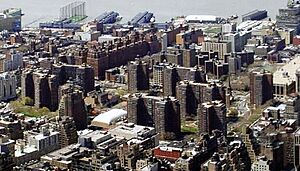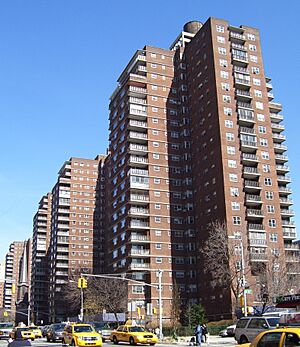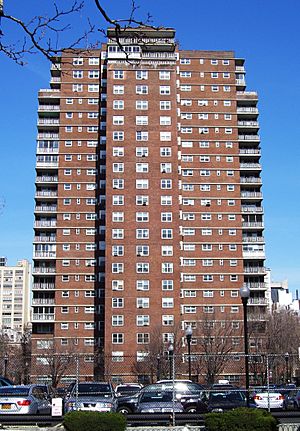Penn South facts for kids
Penn South, also known as Mutual Redevelopment Houses, is a large group of apartment buildings in New York City. It's a special type of housing called a housing cooperative. This means residents own shares in the co-op, not their individual apartments.
Penn South is located in the Chelsea neighborhood of Manhattan. It sits between Eighth and Ninth Avenues, and West 23rd and 29th Streets. The complex has 2,820 homes in ten tall buildings, each 22 stories high. It got its name "Penn South" because it's southwest of New York Penn Station.
Contents
How Penn South Was Built
Planning New Homes
The idea for Penn South started in 1956. The International Ladies' Garment Workers Union (ILGWU), a workers' group, wanted to build new, affordable homes. They planned to clear old, run-down buildings in Chelsea. The city government supported this plan.
However, many people already lived where Penn South was to be built. About 7,500 residents would have to move. This caused a lot of concern and protests. People didn't want to leave their homes.
To help, the plan was changed to save some important buildings. Four churches were saved, including the Church of the Holy Apostles. This church later became a famous landmark.
The government provided money to help with the project. In 1959, it was decided that the old buildings would be taken down. The ILGWU bought the land and started helping residents move. Moving was difficult for some, and there were protests. The city even made new rules to make sure people were treated fairly when they had to move.
In the end, most families moved peacefully. They received money and help finding new places to live. About 600 of the original families were even able to move back into the new Penn South apartments.
Building the Community
Construction on Penn South began. Some people wanted to add "Chelsea" to the name to show it was part of the neighborhood. The state government also provided money for the project.
An old theater, the Grand Opera House, was taken down to make space. Later, a new theater was built in Penn South, which is now used by the School of Visual Arts.
In 1961, construction was delayed by a workers' strike. But the work continued.
A special ceremony was held on May 19, 1962, to celebrate the opening. President John F. Kennedy attended and spoke. He praised the workers and said Penn South was a great example of what could happen when people worked together. An African-American-run bank, Carver Federal Savings and Loan Association, also opened a branch in Penn South in 1963. This was a big step, as it was the first time such a bank operated in a neighborhood that wasn't mainly African-American in New York City.
Penn South Today
Over the years, Penn South helped the Chelsea neighborhood grow and improve. Many of the original families who moved out were able to return to the new apartments. By 1983, about 600 of those families were living there again.
Penn South is known for being a very well-run cooperative. Over time, new features were added for residents. A community garden and programs for seniors opened in 1986. An exercise room and playground were added in 2000. The buildings have also been updated with new systems for electricity and heating.
In 2016, Building 7 of Penn South was added to the National Register of Historic Places. This is because Bayard Rustin, a famous civil and gay rights activist, lived there for many years.
What Penn South is Like
Penn South has 2,820 apartments spread across ten red-brick buildings. Each building is 22 stories tall. The entire area covers about 36 acres.
The apartments have between 2 and 6 rooms. Many people want to live in Penn South because it's a great place. In 2012, there were 6,000 people on a waiting list to get an apartment! In 2014, nearly 50,000 people applied for just 1,200 empty apartments through a lottery system.
Even though many residents were middle-class, they were known for their strong community spirit. For example, during a money crisis in New York City in 1975, Penn South residents paid their rent early. This helped the city get money when it was almost broke.
Penn South is also special because it generates much of its own power. It uses gas instead of oil, which saves money and is more efficient. By 1986, the co-op was making most of its own electricity, heating, and cooling.
Penn South is easy to get to. Several city buses serve the area, and the 23rd Street subway station is nearby. It's also close to popular spots like the High Line park, Chelsea Market, and Hudson River Park. There's even a public school, PS 33, and Chelsea Park right next to Penn South.
Keeping Homes Affordable
To help keep the homes affordable for people with lower incomes, New York City gave Penn South a special tax break. From 1961 to 1986, the taxes on Penn South properties were kept low.
When this tax break ended, the residents voted to slowly increase their taxes over 25 years. This was approved by the city. Later, in 1999, property values in Chelsea went up a lot. Penn South asked the city for more help with taxes.
In 2001, the city agreed to calculate Penn South's taxes based on the cooperative's income. This is similar to how other affordable housing programs work. In return, Penn South agreed to remain a limited-equity cooperative until 2022. This means there are limits on how much residents can sell their shares for, which helps keep the homes affordable.
These agreements have been extended several times. In 2011, residents voted to extend their contract with the city until 2030. In exchange, the city gave the co-op money to update its heating and cooling systems. In 2017, the city council extended Penn South's tax break until 2052, making sure it stays an affordable place to live for many more years.




